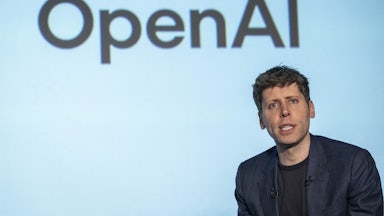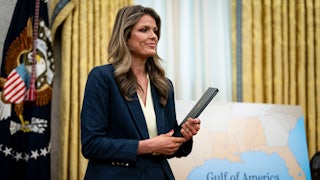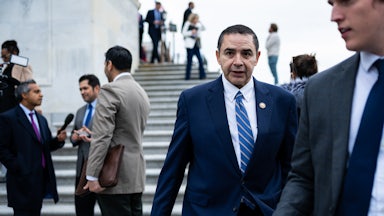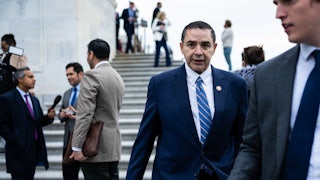I hate logging onto X these days because the platform promotes conservatives and downgrades links to stories from serious news organizations. But I also hate X because so much of what I see is fighting among Democrats. Some of these debates are important, such as assessing if the Biden administration should have done more to prevent what has turned into an Israeli-induced famine in Gaza, or which mayoral hopeful would run New York City best.
But at times, it’s as if we are amid the 2016, 2020 (and likely 2028) Democratic primary cycles, with centrists who seem determined to lambaste the party’s progressives (and vice versa), rather than either side concentrating on how Donald Trump is destroying the republic.
Here’s my attempt at an intervention. What’s needed is a clearer sense of roles within the party and the broader anti-Trump movement. Democratic politicians in Boston, Seattle, and other very progressive areas and left-leaning intellectuals and activists don’t need to be analyzing every action they take through the minds of Wisconsin swing voters. At the same time, Democratic politicians in purple and red states probably can’t always adopt the most forthright positions on sexism, homophobia, transphobia, excessive corporate power, racist policing, right-wing Christianity, and other ills of American society and get elected in those places. We need socialists, progressives, liberals, centrists, Democrats, independents, moderate Republicans, union organizers, business owners, elected officials, and lots of others to join together in the fight against Trump and the MAGA wing of the Republican Party—and agree to disagree on many policy issues.
While my ideological views are closer to those of Senators Bernie Sanders and Elizabeth Warren, many leftists/progressives are just as guilty as the rest of the party of one major sin: trying to come up with some coherent agenda everyone in the anti-Trump coalition has to agree to. This push for policy and messaging unity comes from a sincere place. A political party is in many ways a big brand. And the assumption by many Democratic thinkers is that winning elections means creating a brand that can win in small towns, cities, and states across the country. So that leads to asserting that the Democrats, everyone in the party, must be for creating abundance, fighting oligarchy, defending the working class, or whatever idea some faction of the party is promoting.
And according to this theory, no one with any prominence in the party can be for reducing police funding, allowing transgender girls to play high school sports, or anything else that polls badly in red or purple America.
This push for a single Democratic identity creates bad dynamics. Center-left Democrats spent the weeks after the 2024 election bashing liberal groups such as the American Civil Liberties Union for pushing Kamala Harris and other Democrats who ran in the 2020 primaries toward ideas that were unpopular with the general electorate. That’s wrongheaded. The ACLU is an activist group—its function is to push its preferred policies. Harris is a politician—her job is to win elections. The ACLU wasn’t wrong to advocate its ideas—Harris was wrong to adopt those ideas if she couldn’t successfully defend them on the campaign trail. (I am not sure that Harris’s comments in 2019 doomed her five years later, but the example illustrates the problem of not understanding that different players have different lanes within the Democratic coalition.)
Let me flip this around and explain a healthier coalition politics. In the fall of 2023, only a few weeks before the Kentucky gubernatorial election, I wrote a piece praising Governor Andy Beshear for being a normal Democrat on policy (pro–abortion rights, pro-trans, pro-labor), even though he’s in a red state. I emphasized that Beshear, unlike ex-Senator Joe Manchin and many other red- and purple-state Democrats, almost never bashes the party’s progressive wing.
Was that piece electorally helpful for Beshear? Probably not. The campaign of Beshear’s opponent, then–Kentucky Attorney General Daniel Cameron, sent out a press statement noting that a Washington Post writer had said that the governor was a conventional liberal.
But Beshear’s staff, which had granted me an interview with the governor, did not afterward criticize me or suggest I was hurting their candidate. Nor did other Democrats here in Kentucky, where I live. They understood that while I strongly favored Beshear over Cameron, I am an independent writer with progressive policy tendencies. My job was not to get Andy Beshear elected by casting him in the terms most favorable to the state’s conservative-leaning voters. My job was to give my honest portrayal of the governor, particularly to progressives who follow my work. (Disclosure: My wife currently works in a policy role in the Beshear administration.)
Similarly, a healthy anti-MAGA politics is one that recognizes Michael Bloomberg and Bernie Sanders disagree on the proper role for billionaires in politics but can unite around slamming the president’s authoritarianism. People who live in states where housing is relatively cheap and easy to build aren’t going to see reducing regulations and other ideas from the party’s abundance faction as resonant as those on the coasts do, and that’s OK. Activists who call for defunding the police aren’t speaking for the Michigan Democratic Party. Zohran Mamdani isn’t coming up with a policy agenda that Pete Buttigieg should run on nationally in 2028.
We live in a big country—many different approaches can coexist. And they must. A party that represents more than 75 million people will inevitably have policy diversity. So do the Republicans. There may not be any truly moderate Republicans left, but Utah Governor Spencer Cox and Maine Senator Susan Collins aren’t as conservative as Trump.
And policy coherence isn’t necessary because Americans vote for individuals, not parties. Yes, there are fewer swing voters and states than ever. That said, Beshear is the governor of Kentucky, Collins a senator in Democratic-leaning Maine, the socialist Mamdani poised to be the mayor of one of the centers of modern capitalism. Candidates really matter. And conversely, the party brands are entrenched and hard to change. The Democrats aren’t going to win many U.S. Senate races in Alabama, even if they talk about racial inequality a bit less these days than in 2020.
So, while I deeply care about policy, I don’t think anti-Trump operatives, thinkers, and officials need to fully align on a governing vision until Democrats are in power and writing legislation. Because Trump won and is implementing the hard right’s favorite ideas, many Democrats are arguing that the party needs its own Project 2025. I disagree. Project 2025 was an electoral disaster (Trump distanced himself from the platform during the campaign) and is a bad model for governing. The party platform produced by the Democratic National Convention and laws written by Democratic members of Congress and a Democratic executive branch allow more input from all parts of the coalition than a few unaccountable think tanks and intellectuals coming up with an agenda for the whole party.
Liberal policy experts should feel free to debate policy issues, but I would strongly encourage them to make sure they are mainly using whatever power they have to fight Trump right now. I worry some in the party are spending too much time positioning themselves and their ideas for a 2029 Democratic administration, instead of making sure there’s a Democratic administration in 2029 in the first place.
The critical questions for Democrats in the near term are how they slow Trump and how they win the elections in 2026 and 2028. To be sure, these are questions that involve policy and messaging. But they don’t require a consistent, unified, across-the-board vision. Winning a swing U.S. House district in New York or California is almost certainly going to involve different messages and policies than next year’s U.S. Senate races in Ohio and North Carolina.
What about 2028? Everyone in the anti-Trump coalition doesn’t need to align with the policy vision of Beshear, Buttigieg, Maryland Governor Wes Moore, or whoever wins the primary. They just need to vote for that person. Even the Democratic nominee doesn’t need a full-fledged governing plan. Obama’s policy ideas weren’t a big feature of his landslide 2008 victory. In 2020, Biden’s success in the general election wasn’t because he chose the ideas of the party’s left or center but because he promised to work with both wings if he won.
I am absolutely not calling for a moratorium on Democrats criticizing one another or having policy debates until Trump is out of office. But the urgency and intensity of these intraparty disputes should be greatly reduced. Coming up with policies and messages that unite an ideologically diverse coalition is extremely complicated. Making sure that most people in Arizona, Georgia, Michigan, North Carolina, Pennsylvania, and Wisconsin vote against JD Vance (or whoever is the Republican nominee) on November 7, 2028, is a slightly easier task—and that’s the only one Democrats must do collectively.










